Double Gauze Swaddling Blankets
It may take some restraint to leave a good thing alone, but sometimes the best materials require very little effort to shine! This Kokochi Double Gauze from Kiyohara is just such a good thing. It’s whisper soft and feather light and is woven with a beautiful color on one side and cool white on the other. In short, this fabric is perfect for a set of utterly simple Double Gauze Swaddling Blankets.
 Swaddling itself is so simple and low-tech. Just a few wraps and tucks and a baby goes from angry to angelic in seconds. What a gift for new parents! Plus, swaddling blankets make themselves useful way beyond just swaddling, as impromptu picnic blankets, nursing cover-ups, stroller sunblockers and even burp cloths. With just a little cutting and four simple seams this Double Gauze cotton becomes one of the most beautiful swaddling blankets around! -Molly
Swaddling itself is so simple and low-tech. Just a few wraps and tucks and a baby goes from angry to angelic in seconds. What a gift for new parents! Plus, swaddling blankets make themselves useful way beyond just swaddling, as impromptu picnic blankets, nursing cover-ups, stroller sunblockers and even burp cloths. With just a little cutting and four simple seams this Double Gauze cotton becomes one of the most beautiful swaddling blankets around! -Molly
Materials

To make one blanket you will need…
- 1 ½ yards of Kiyohara’s Kokochi Double Gauze. I used the colors Beige, Pink, Yellow, Gray, and Silver Gray Dots.
- 110-yard spools of Gutermann’s Cotton Thread to match your fabric. I used color 4660 for the Beige and Pink, color 8915 for the Yellow, and color 9090 for the gray fabrics. (One spool is enough to make several blankets.)
Size
Finished Dimensions: 42 inches square
Note
Prewash and dry the fabric.
Pattern
This pattern is also available as a free printer-friendly PDF. Just click here!
Cut

You will be cutting the fabric into a 44-inch square. Here’s how…
Because this fabric is so soft and airy it tends to slip around, making it a bit tricky to cut straight and on grain. For the dotted fabric, the best way to get a straight cut is to use scissors and follow along one of the lines of dots as shown above.

For a straight cut on the solid fabrics use as a guide the faint indentations that bind the two sides of the fabric together every ¾ of an inch. They are hard to see in a photo, so I added gray dots to indicate them in the photo above. You will notice that my dots don’t seem to make an entirely straight line, but don’t be fooled. This line is on grain, which is more important than whether it looks straight to your eye.
Starting roughly 2 inches in from one of the fabric’s raw edges, cut a straight line from selvage to selvage.
From this straightly cut side measure 44 inches along the selvage and then cut the opposite side at that point in the same manner.

Then cut off one of the selvages using scissors and cutting just above where the tighter weave of the selvage ends.
Measure 44 inches from this cut and then cut the opposite selvage side by following either a row of dots or indentations.
Sew

Press one raw edge in ½ inch twice towards the lighter side of the fabric. Pin this fold in place.
Repeat for the opposite raw side of the square.
Sew these two folded sides down with a 3/8-inch seam allowance.
Note: It makes for a neater edge if you sew this seam using a 3/8-inch seam allowance rather than edge stitching the fold.
Sew the remaining two raw sides down in the same manner and you’re all done.

Update 2024: You can explore our current collection of beautiful fabrics and supplies on our page of Sewing Tools + Notions!

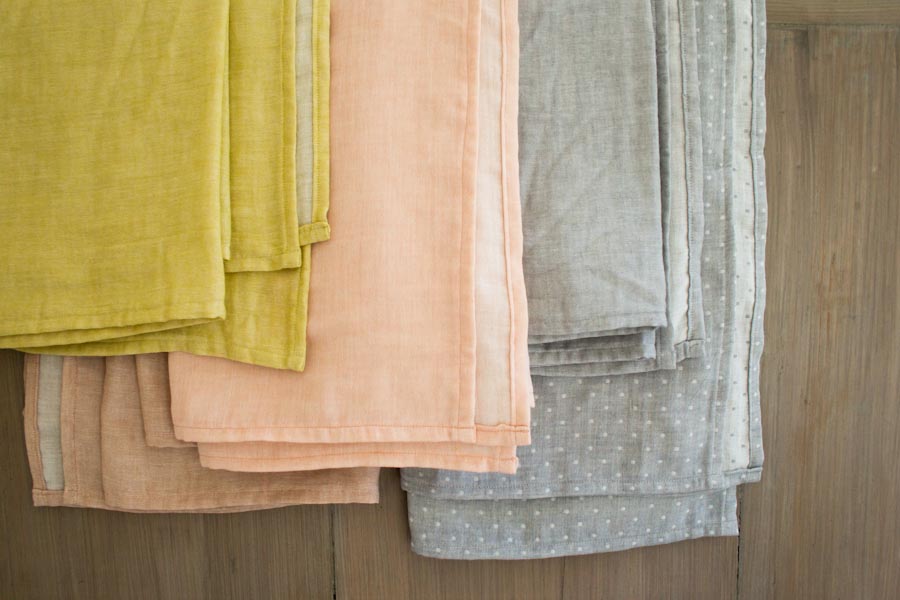

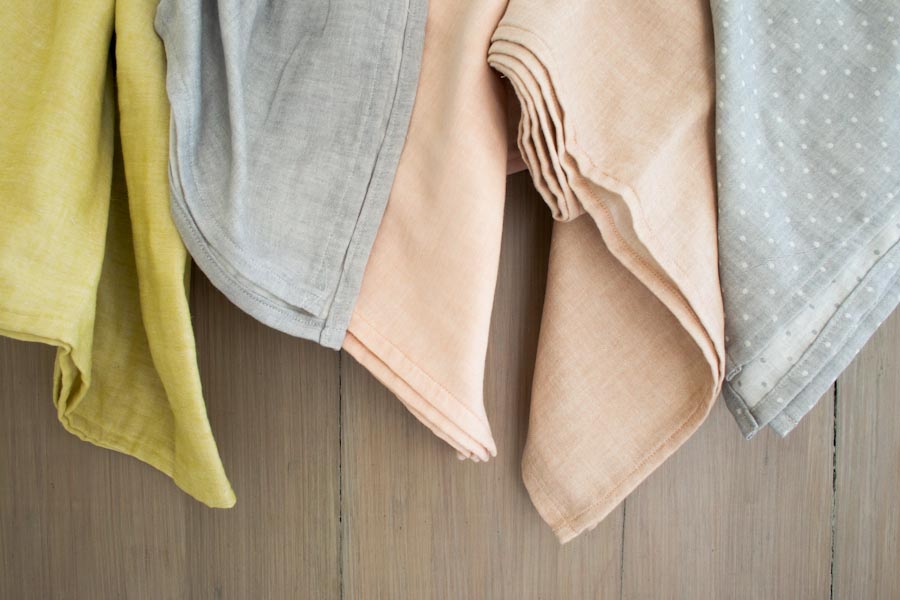
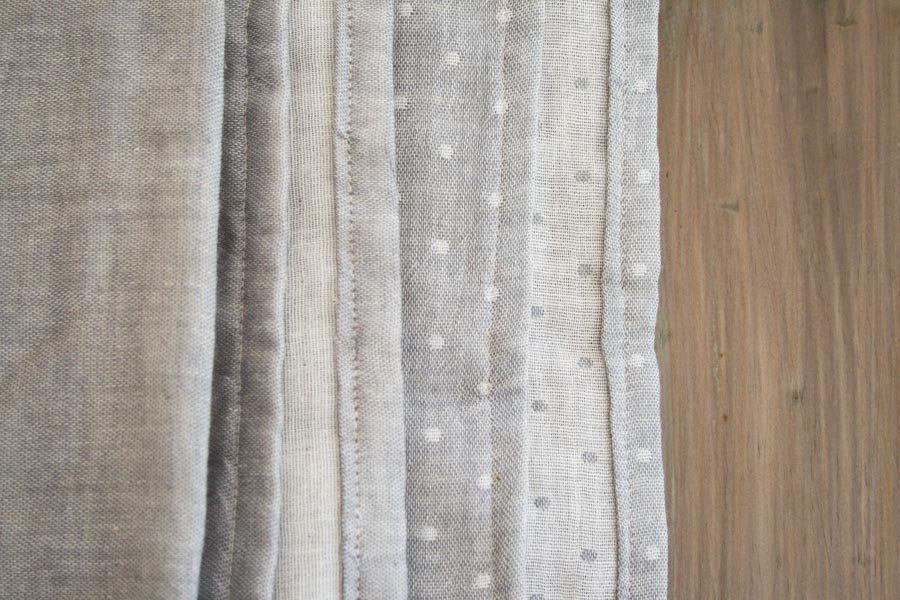
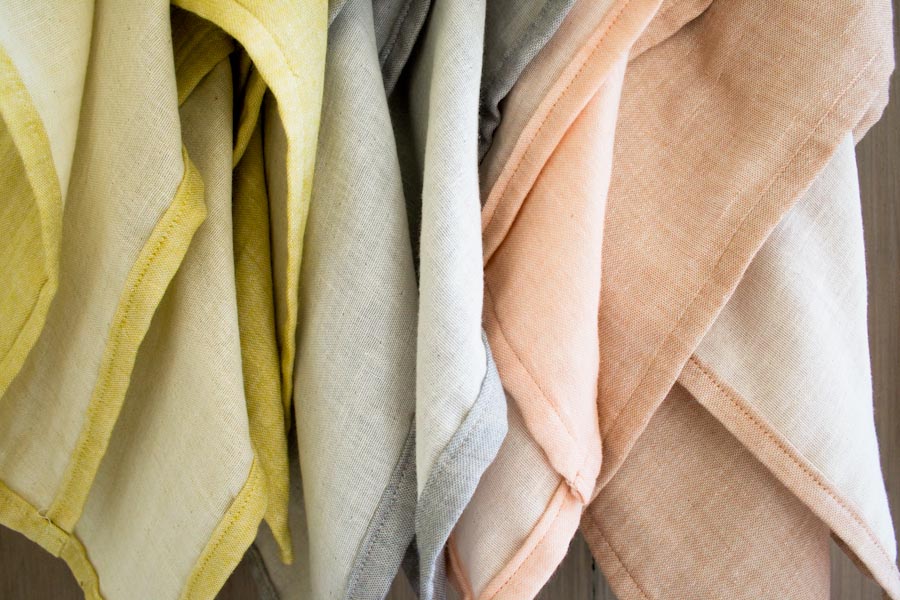


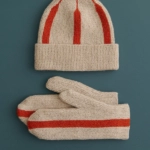

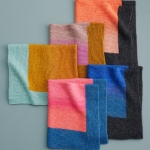
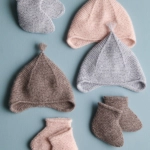


Love it!!
I would also love to see other ideas/projects using this fabric!
Simply beautiful ! These will work great for some babies that are coming into my life soon.
This fabric looks soft and pliable. I am wondering if it would be appropriate for napkins? Are there samples available?
Hi Jane-
Sure, this would work well for napkins! We don’t send out samples but we do cut as small as a quarter of a yard and ship everywhere. Or, if you are in the NYC area you can always come into our store and take a look.
Thanks for getting in touch!
Molly
Thanks for the awesome tut!
I’m thinking about trying this in a king-sized version. I want to double up the layers and it’ll need to be constructed of panels due to the yardage width, but I think it could work. Do you have any tips on working with this fabric in a larger size?
Hi Tifa-
If you connected the panels with french seams it could work. Or, you might want to consider backing it more like this project: https://www.purlsoho.com/create/2011/09/05/mollys-sketchbook-swaddling-blankets/
Thank you for getting in touch and please let us know if you have any other questions!
Molly
Thank you!
Do you have a favorite french seam tutorial out there? I checked the site, but I didn’t find one.
Hi Tifa-
We don’t have a French Seam tutorial, but it is something we should add! In the meantime a French seam is explained in the following story, just scroll down to the “cutting and piecing together” section.
Thanks!
Molly
Hi! I know this is an older post but I’m hoping you can help me. I really love these swaddle blankets but it doesn’t seem to matter what I do, I can not keep the fabric from stretching out as it goes under the machine. I’ve tried lots of pins, loosening the foot, tear away stabilizer (which works but I can’t get it all off whitout tearing up my stitch), and I can’t find a solution! How did you keep yours from stretching out? Thanks!!
Hi Kelli-
I’m so sorry to hear that you’re having this problem! Are you using the same fabric that we used for this post? If so, I sewed these with a regular presser foot with the automatic medium weight woven fabric setting on my machine, a Viking Sapphire 875, with no problems. However I can see how this fabric might stretch out because of its unique weave. I would suggest that you use a walking foot to take care of this problem.
If you are using a different fabric, or this doesn’t solve your problem, please get back in touch and we can try to get to the bottom of it!
Best-
Molly
Molly, did you iron down your 1/2″ hem before sewing? Are you even allowed to iron double gauze? I’m using a different fabric brand than what you used, but it’s still gauze.
After I washed and dried my gauze, it was wrinkly. I’m not sure how to move forward from here..
..but i’m eager and excited to make my first swaddle blanket!
Also, is a straight stitch okay to use? What stitch and length is most durable, I want these to last!
Hello Kylee!
Thank you for writing in! Sorry for the delay in our response! We did iron down the 1/2″ hem before sewing. You can totally iron double gauze and we recommend it since gauze tends to be a bit slippery the an ironed hem will be easier to sew. Yes, a straight stitch is great to use and I would recommend trying a few different lengths on some scrap gauze to find one that you like best.
Please let us know if you have any more questions!
Best wishes,
Kumeko
Hi there!
Did you prewash any of the double gauze fabric? it does change in shape and texture.
Thanks!
Aisha
Hi Aisha,
Thanks for writing in! We recommend prewashing and drying this lovely fabric! In general I treat the raw fabric as I would like to treat the finished item, washing it and drying it as it will be when it is a swaddling blanket. Double gauze, which is already soft, will soften a bit more on first washing as the sizing that comes on all fabric washes out, leaving just the lovely, soft fabric. There may be some shrinking but not too significant so long as it is not washed in very hot water.
I hope that this helps!
Cassy
Hi there!
Beautiful fabric! Question: would this be lightweight enough for a baby blanket in Texas? It is starting to warm up here and I need to make my little one some blankets for nighttime/stroller use. I refuse to pay $40+ for the blankets at the store, lol.
Thank you!
Jessica
Hi Jessica,
Thanks for writing in! The Kokochi Double Gauze is wonderfully light and airy and probably just what you are looking for! I raised two babies through the heat of Southern California summers, and double gauze would add the perfect lightweight layer when you need it!
I hope that helps!
Julianna
I love this. Double gauze is so soft and makes a beautiful gift. I’ve made baby blankets with a coordinating bias binding or else with a narrow hem. The fabric is very soft and slippery to sew, use a fine needle and a walking foot. Do a tension sample! If you don’t have a walking foot press and pin well. I find it easier to cut a 17 cm curve on the corners instead of the method shown here. To make a narrow hem sew 5mm from edge. Press edge back on the stitching line. Sew another line all the way around, close to the edge (about 3 mm) Trim all the loose threads and press the hem back one more time and pin. Sew close to hem edge and if you want a heavier hem sew around again close to outside edge. This is a lingerie technique and works really well with double gauze.
Will you be getting more of your quilted double gauze? I was so disappointed to not find any!
Thank you
Hi Sue,
Thanks for reaching out! Nani Iro prints and fabric bases change every season, so it’s really hard to say, although I’m hopeful that they will include quilted double gauze again in a future release! Currently we only have Nani Iro Linen Sheeting in stock, but you could combine it with some batting and a plain backing fabric, like muslin, and some simple straight line quilting to use it for projects like our Pure + Simple Quilted Blankets or Puffy Tote.
I hope that helps!
Julianna
I was looking for this information relating to such double gauze swaddling blanket. You have really eased my work by posting this article, loved your writing skill as well. Please keep sharing more, would love to read more from you!